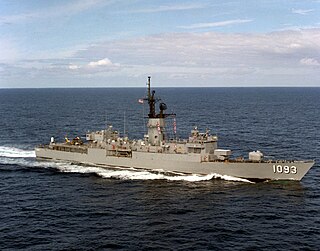TCG Mauvenet may refer to one of the following ships of the Turkish Navy:

USS Saratoga (CV/CVA/CVB-60), was the second of four Forrestal-class supercarriers built for the United States Navy in the 1950s. Saratoga was the sixth U.S. Navy ship, and the second aircraft carrier, to be named for the Battles of Saratoga in the American Revolutionary War.

Jeremy Michael Boorda was a United States Navy admiral who served as the 25th Chief of Naval Operations. Boorda is notable as the first person to have risen from the enlisted ranks to become Chief of Naval Operations, the highest-ranking billet in the United States Navy.

USS Estocin (FFG-15), ninth ship of the Oliver Hazard Perry class of guided-missile frigates, was named for Captain Michael John Estocin (1931–1967). Ordered from Bath Iron Works on 27 February 1976 as part of the FY76 program, Estocin was laid down on 2 April 1979, launched on 3 November 1979, and commissioned on 10 January 1981.

The seventh USS Ranger (CV/CVA-61) was the third of four Forrestal-class supercarriers built for the United States Navy in the 1950s. Although all four ships of the class were completed with angled decks, Ranger had the distinction of being the first US carrier built from the beginning as an angled-deck ship.

USS Sampson (DDG-10), named for Admiral William T. Sampson USN (1840–1902), was a Charles F. Adams-class guided missile destroyer in the United States Navy.

USS Spruance (DD-963) was the lead ship of the United States Navy's Spruance class of destroyers and was named after Admiral Raymond A. Spruance. Spruance was built by the Ingalls Shipbuilding Division of Litton Industries at Pascagoula, Mississippi, and launched by Mrs. Raymond A. Spruance. Spruance served in the U.S. Atlantic Fleet, assigned to Destroyer Squadron 24 and operating out of Naval Station Mayport, Florida. Spruance was decommissioned on 23 March 2005 and then was sunk as a target on 8 December 2006.

USS Arthur W. Radford (DD-968) was a Spruance-class destroyer in the United States Navy. She was named for Admiral Arthur W. Radford USN (1896–1973), the first naval officer to be Chairman of the Joint Chiefs of Staff. She was decommissioned on 18 March 2003 after serving for 26 years, and on 10 August 2011 her hull was scuttled off the coast of Delaware to form part of an artificial reef.

USS Cushing (DD-985), named after Commander William Barker Cushing, was the fifth ship of the United States Navy to bear the name. Cushing was a Spruance-class destroyer built by the Ingalls Shipbuilding Division of Litton Industries at Pascagoula, Mississippi. Cushing operated out of Yokosuka, Japan for the last several years of her career. Cushing was the last Spruance-class destroyer to remain in active service, until decommissioned on 21 September 2005.
The Rim of the Pacific Exercise (RIMPAC) is the world's largest international maritime warfare exercise. RIMPAC is held biennially during June and July of even-numbered years from Honolulu, Hawaii, with the exception of 2020 where it was held in August. It is hosted and administered by the United States Navy's Indo-Pacific Command, headquartered at Pearl Harbor, in conjunction with the Marine Corps, the Coast Guard, and Hawaii National Guard forces under the control of the Governor of Hawaii.

The USS Thomas S. Gates (CG-51) was a flight-I Ticonderoga-class cruiser that was used by the United States Navy. The warship was named after Thomas S. Gates, Secretary of Defense in the last years of the Eisenhower Administration (1959–1961).

The Turkish Naval Forces, or Turkish Navy, is the naval warfare service branch of the Turkish Armed Forces.

USS Detroit (AOE-4) was the fourth and last Sacramento-class fast combat support ship built for the United States Navy. She was laid down on 29 November 1966 by Puget Sound Naval Shipyard, Bremerton, Washington; launched 21 June 1969; and commissioned on 28 March 1970. She is the fifth United States Navy ship named after Detroit, Michigan, the largest city in the state of Michigan, and the river of the same name.

USS Capodanno (FF-1093) was the 42nd Knox-class frigate in the United States Navy. It was named after Fr. Vincent Capodanno, recipient of the Medal of Honor.
The Fleet Problems are a series of naval exercises of the United States Navy conducted in the interwar period, and later resurrected by Pacific Fleet around 2014.

Gulf of Saros or Saros Bay is a gulf north of the Dardanelles, Turkey. Ancient Greeks called it the Gulf of Melas.

USS Gwin (DD-772/DM-33/MMD-33) was a Robert H. Smith-class destroyer minelayer in the United States Navy. She was named for William Gwin.

USNS Powhatan (T-ATF-166) was the lead ship of the United States Navy Powhatan-class fleet ocean tugboats. She was in service with the U.S. Navy from 1979 to 1999, and then was leased to a private towing and salvage company. At the end of the lease in 2008, the ship was sold to the Turkish Navy which recommissioned her as TCG Inebolu.
Recep Bülent Bostanoğlu is a retired Turkish admiral, who served as the Commander of the Turkish Naval Forces between 2013 and 2017.

TCG Barbaros is the lead ship of Barbaros-class frigate of the Turkish Navy.















